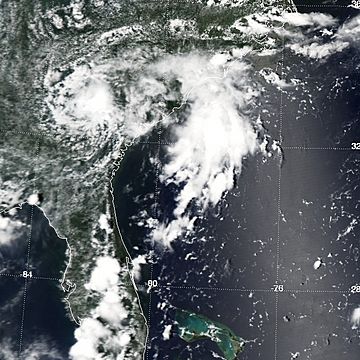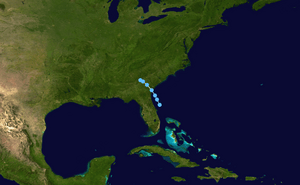Tropical Depression Seven (2003) facts for kids
| Tropical depression (SSHWS/NWS) | |

Tropical Depression Seven
|
|
| Formed | July 25, 2003 |
|---|---|
| Dissipated | July 27, 2003 |
| Highest winds | 1-minute sustained: 35 mph (55 km/h) |
| Lowest pressure | 1016 mbar (hPa); 30 inHg |
| Fatalities | None reported |
| Damage | Minimal |
| Areas affected | Florida, Southeast United States |
| Part of the 2003 Atlantic hurricane season | |
Tropical Depression Seven was a weak weather system that formed near the coast of Florida. It was the seventh tropical cyclone of the 2003 Atlantic hurricane season. This depression started on July 25 from a "tropical wave." A tropical wave is like a ripple in the air that can help storms form.
Tropical Depression Seven was small and not very organized. It never grew strong enough to become a tropical storm. A tropical storm is much stronger than a tropical depression. The system moved onto land at St. Catherines Island in Georgia. After reaching land, it quickly became weaker. Because the storm was not strong, it only caused some heavy rain. This rain fell in Florida, Georgia, South Carolina, and North Carolina.
Contents
How Tropical Depression Seven Formed and Moved
A "tropical wave" helped create this weather system. This same wave had also caused another storm, Tropical Depression Six. On July 23, 2003, this wave mixed with an area of low pressure high in the sky. This created a large area of thunderstorms near Hispaniola.
A swirling motion started to form inside the storm. This happened as it moved mostly toward the north-northwest. Scientists believe the system became Tropical Depression Seven on July 25. This was about 60 miles (95 km) east of Daytona Beach, Florida.
The Storm's Path and Weakness
At first, the depression moved west-northwest at about 13 mph (20 km/h). Most of its thunderstorms were separate from the center of the storm. But then, the clouds started to get more organized. They formed curved bands, like arms wrapping around the center.
The storm kept moving northwest during its short life. It was guided by strong air currents. These currents came from a high-pressure area and a "trough" that was moving closer. A trough is an extended area of low atmospheric pressure.
Tropical Depression Seven moved over cool ocean water. It also faced strong winds high in the atmosphere. These conditions made it hard for the storm to get stronger. Its winds never reached more than 35 mph (55 km/h). This meant it could not become a tropical storm.
Before the storm reached land, its strongest winds were in a small area. This was northeast of its center. Here, a clear group of clouds stayed together. Early on July 26, the depression moved onto St. Catherines Island in Georgia. It slowly weakened over land and finally disappeared on July 27.
What Happened Because of the Storm
Weather experts never thought this depression would become a tropical storm. Because of this, no special "tropical storm warnings" were put out. However, officials did issue "flood watches" for parts of Georgia and South Carolina. In Georgetown County, South Carolina, local leaders watched the storm carefully.
The depression brought light to moderate rain from Florida all the way to the coast of North Carolina. The most rain fell in Savannah, Georgia. That area received 5.17 inches (131 mm) of rain. Other places commonly got 2 to 3 inches (50 to 75 mm) of rain. Luckily, this depression caused no damage or injuries.
Related Pages
Images for kids
-
Damage from Hurricane Fabian on Bermuda



